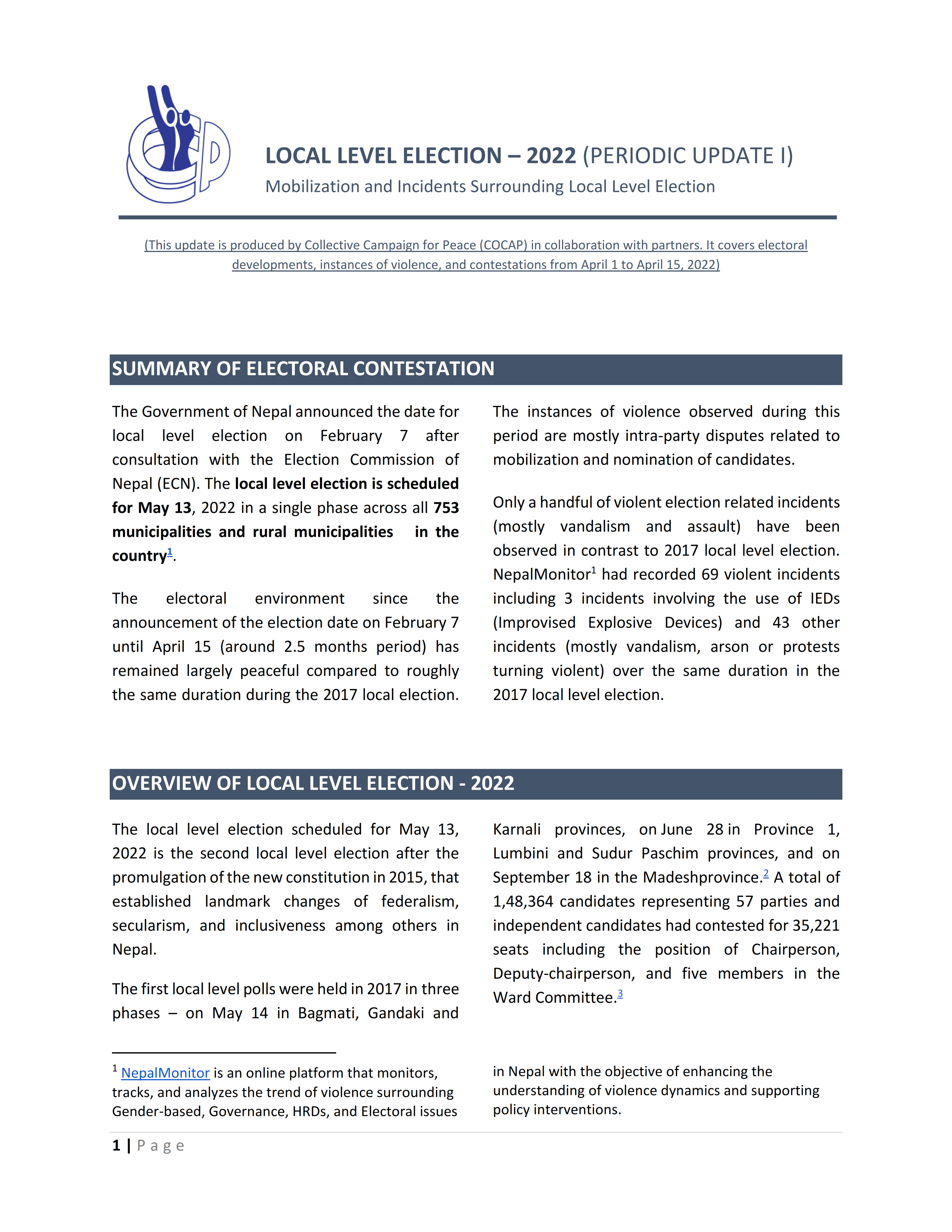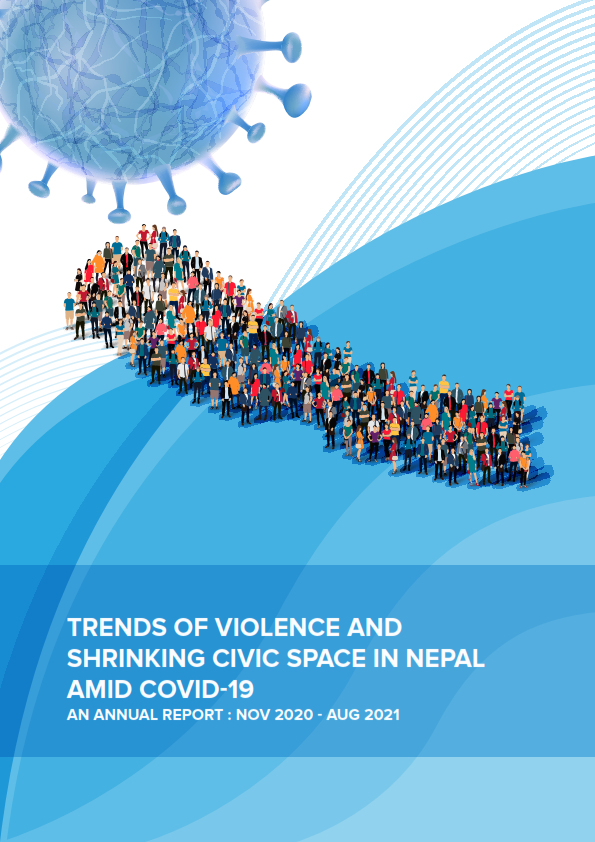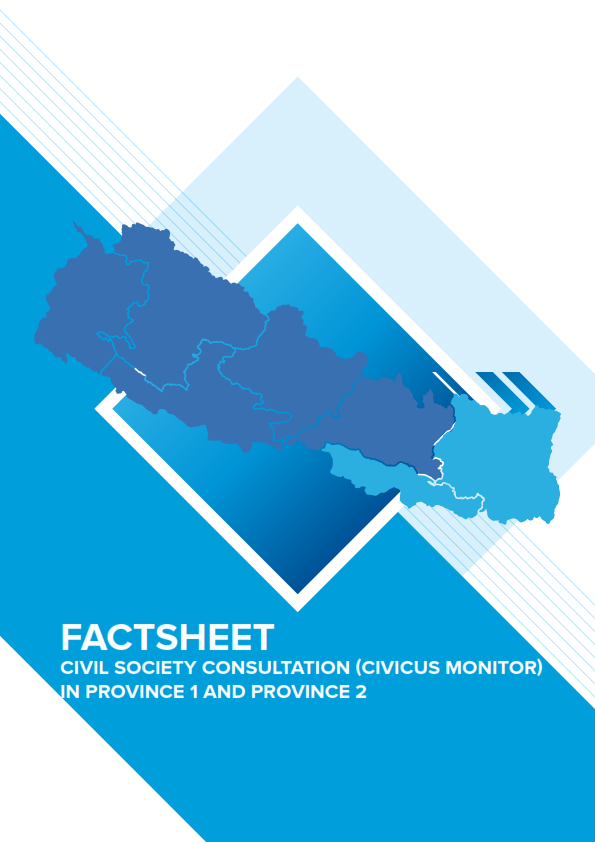Incident Reports
THRD Alliance's Situation Report
2015-09-09
A THRD Alliance team visited Bara, Parsa and Rauthat districts to monitor inexplicable use of curfew and recorded first-hand information on the situation of human rights in the Terai in the face of the ongoing agitation launched by Madhesi and Tharu people on 9 August. A total of 12 protesters have been killed in this part of the Central and East Terai. THRD Alliance was able to investigate seven of them. There is a serious concern that at least two out of the protesters killed on 31 August and 1 September (Raj Kishor Thakur in Rauthat and Dilip Chaurasiya in Parsa) in police firing were hit in the back.
This suggests that the Nepal Police and Armed Police Force were shooting when people were fleeing rather than posing an imminent threat to life. One victim was shot twice while he lay injured on the ground (Hefajat Miya Ansari in Bara). All victims were found to have sustained bullet injuries above the knee in the head, chest and stomach, further suggesting that police were not minimizing their use of lethal force, as required under both international standards and national law. Although the government has imposed a curfew in some district headquarters of the Terai, mainly to ease supplies getting to Kathmandu, the blocking of roads with trees and boulders by the local people, including by many youths suggest that the people of Madhes are supporting the ongoing agitation. Because the agitation has now become a matter of prestige for the Madhesi and Tharu people, the cadres of the agitating parties have brought food to the main centres of the district and are camping on the street to try to ensure the success of their agitation. However, since this is a time to cultivate their crops, it will be costly for these rural cadres to remain on the street for long.
Parsa Five people died in Birgunj as a result of police opening fire on 31 August and 1 September. Dilip Chaurasiya, 28, a local resident of Parsa’s Maniyari VDC, was shot in the back near Parsa DDC on 31 August. He was rushed to Narayani Sub-regional Hospital, where he died. Dharma Raj Singh (30, of Bhawanipur, Maniyari), Bhola Prasad Sah and Dinanath Sah were killed at Laxmanuwa Chowk in Birgunj on 1 September. Sohan Kalbar died on the spot after being reportedly hit by a police bullet at Naguwa Chowk on the same day. According to Dinesh Chandra Giri (local leader of the CPN-UML), the local residents of Parsa districts had initiated a protest, including by blocking the highway during the daytime from mid-August. At night the administration escorted lorries past the blockades to ensure supplies to Kathmandu.
From 28 August, all Madhesi leaders had agreed to gather near Ghantaghar, Birgunj and organize a political gathering, which had initially attracted around 4-500 people. Protestors had also organized a peaceful sit-in on the road near Nagwa, Birgunj to block any type of supplies to Kathmandu. In the evening police started removing the protestors, using a baton charge. Police also opened fire on the protestors after which Amiri Lal Raut1 fell down after receiving pellets in his stomach. Along with him, 15 more people were injured. From that day (28 August), this area was declared as prohibited by the local administration and on the next day (29 August) a curfew was imposed. Because of the curfew, the local residents became angry and claimed that, if they were not able to protest, the state was not going to give them any rights. With this anger, the protestors forced the police to withdraw from the Ranighat Police Station. They also set Parsa CPN-UML's party office on fire. During this incident, Dilip Chaurasiya, a local resident of Birgunj, a resident of Maniyari-25, Birgunj received a bullet in his back. The death of Dilip Chaurasiya on 31 August caused more unrest with people from different neighbouring villages joining the agitation on 1 September. The situation became tense during this day. There was a clash between police and the protestors when the agitators defied the curfew order at around 7:30 am. On the same day (1 September) Shanta Lal Yadav was injured when police opened fire on the people sitting at Inarwa chowk, Birgunj.
After such occurrences, the local residents of Parsa district were incensed and their leaders along with the local residents said that they did not want any police offices in Parsa. Laxman Lal Karna, the deputy president of Sadbhavana Party, stated that the root causes of such incidents are the proposed seven state-federal model and the efforts of the state to ensure that supplies continued to reach Kathmandu. Bara The proposed seven states federal set-up, also caused the local residents of Kalaiya, headquarters of Bara district, to become agitated. Pramod Gupta, the ex-constituent assembly member from the Federal Socialist Forum, Nepal, stated: “peaceful protest and corner assemblies were taking place. Every day, 100-150 protestors joined the protest and by the evening of 31 August at Kalaiya chowk, we (the political parties) had organized laathi julus and around 20,000 people from different villages had joined the rally. It was a completely peaceful rally without incident ”
On 31 August at 4 pm, around 30 protestors gathered near Dharmasala Chowk, to continue the agitation. Suddenly, a group of police arrived and immediately resorted to a baton charge. Everyone was shocked. The protestors were scattered after the laathi charge. Then the protestors pelted the police with stones. Police opened fire on the scattered agitators and Hefajat Miya Ansari initially sustained a bullet injury in his right elbow. Eyewitnesses said police fired another two shots at him after he fell to the ground. This video shows a period in the aftermath of this killing. Hefajat Miya’s body lay on the ground for half an hour before a police vehicle arrived to take it away. The video linked below shows the last four and a half minutes of this period.
The images in the video are deeply disturbing and raise serious questions about police discipline and the effectiveness of commanders’ control of their men. The police are shown making repeated obscene gestures at the unseen demonstrators. In Nepalese culture, the gestures seen are considered to be very offensive. The police can be seen directing an endless stream of invective at the demonstrators and eyewitnesses said that the language used was racist in the extreme. There is no attempt made to treat the body with any respect. At one stage, some 20 police can be seen gathered around it as if it was some sort of spectacle. Eyewitnesses said that in the period of 25 minutes before this video was taken, police were seen kicking the body and that DSP Binodh Sharma urinated on it; an allegation THRD Alliance was not able to confirm. On the same day (1 September) Rajababu Sah (aged 14), a juvenile of Kalaiya 10, received a pellet injury in his cheek when police opened fire on the scattered protestors. Three police personnel from the Nepal Police were involved in this incident. Abhinandan Kumar Gupta (a local resident of Kalaiya-6), a witness, stated that two of them had masks, two carried guns and each one carried a baton.
Rauthat According to local leaders, the reason for the protests in Rauthat was the same: the proposed seven state-federal model. On 24 August, the protestors had gathered in Gaur, the headquarters of Rauthat district, to paint "Madhes Sarkar" on the official board of the government offices. A large number of women participated in this demonstration. The protestors carried "symbolic swords" (made of wood). Yogendra Yadav, the central member of Sadbhawana Party said that until 4 pm the protest was peaceful, Yogendra Yadav stated: “Suddenly, police started resorted to a baton charge on the protestors, which resulted in around sixty-five protestors receiving injuries from rubber bullets.” At around 4:30 pm Rauthat was declared as a riot-hit area. The campaign of replacing the government offices board with "Madhes Sarkar" was continued on 25 August despite the declaration of a riot-hit area. The CDO had also imposed a curfew in Gaur. Despite this, thousands of protestors defied the curfew and came to replace the official boards. The protestors were stopped at a distance of 500 meters from the BP chowk. The situation became tense. The protestors started pelting stones at the police and security reinforcements opened fire on the protestors. Raj Kishor Thakur, a bystander, was killed by police fire while he was making a phone call. (See box 3) Thakur’s dead body was kept in the hospital for a week and no one had access to the hospital as it was totally controlled by security forces. Conclusion The prolonged general strike has made life very difficult in the southern plains.
There is a severe shortage of essentials and medicines. Shops and factories are closed. Daily wage earners have difficulty managing two meals a day. Protesters have set fire to the police stations and government offices. Because of fear of attack, the APF and Nepal police evacuated their personnel from some of its bases in the district in Rauthat, Bara and Parsa. Locals refused to rent their houses to police and refused to sell daily goods to them. This makes police life difficult. Government officials including judges are returning to Kathmandu due to continuous attack on government offices by the protesters. The protesters have also targeted NC and UML party offices. In Parsa, Bara and Rauthat, it was found that police opened fire, hitting people in the back. The Local Administration Act has laid down steps to follow in crowd control the mob, setting out. In none of the protests in the Terai investigated by THRD Alliance, was tear gas or a water cannon used to disperse the mob; rather the security forces used lathis and then immediately resorted to life live ammunition. Moreover, the state needs to think about the scale and nature of the escalating protest. The situation is more dangerous than the state thinks. For instance, Bhairahwa has been declared as a prohibited area, there is no agitation.
Most of the rural areas of Nawalparasi, Kapilvastu, Rupandehi, Parsa and Bara are extremely tense. Because of the excessive use of force by police, people are angry and more violence can erupt at any time. The way Kalaiya residents have decided that their market will not provide any types of service to police personnel should be a matter of deep concern to the police. On Saturday, the last day of the deadline for registering amendment proposals on the draft constitution, the big three parties had the chance to show some flexibility by extending the deadline even by a few days. Over 20,000 people took part in the funeral procession in Birgunj on that day, but the big three parties and the government ignored this event and went ahead as scheduled. This has further angered people in Madhes. The general perception in the Terai is that "the demands of Karnali and Mid-Western region people, particularly the residents of Surkhet, were addressed but the demands of Madhesis and Tharus have been ignored"; “police use water to disperse mass protests in Kathmandu, but fire lives bullets in the Terai. why this different treatment?" These are the questions we heard everywhere. If the big three parties continue to ignore the concerns of the Madhesi and Tharu people, that could cause further anger which could lead to communal clashes in the southern plains. Recommendations To the international community: 1. Bring the three parties/government and the agitating Madhesi, Tharu and Janajati groups to the negotiating table to find a solution to the key issues regarding the Constitution, including federal boundaries, citizenship, proportional inclusion and demarcation of electoral constituencies. 2. Advice the government to create a suitable environment for the aggrieved groups to come back into the constitution process. 3. Encourage the security forces to minimize the use of lethal force, as required under both international standards and national law. 4. Ask the protesting parties to seek a peaceful resolution; to ensure no children take part; not to stop the public from renting rooms and selling daily goods to the security forces. 5.
Ask the Constituent Assembly to consider allowing the necessary time to facilitate solutions to the current stand-off. NHRC 1. Carry out impartial and credible monitoring of protests in terms of International principles regarding crowd control and Excessive Use of Force by state security forces and possible misuse/inappropriate use of curfews 2. Immediately investigate the killings at Parsa, Bara, Rauthat, Tikapur, Bhardha and Bhairhwa and recommend prosecution of those responsible for the deliberate or indiscriminate killing of protesters and excessive use of force. 3. Release the report as soon as possible with a specific recommendation to use lethal force only when absolutely necessary to protect life. 4. Recommend compensation to the victims’ families. The government 1. Reverse the 24 hours curfews and unnecessary prohibitory order at a time when people are expressing their concern on the constitution. 2. The government should immediately provide compensation to the victims and provide a rehabilitation package to the family members of those who were killed. 3. Ensure proper treatment of the injured. The security forces 1. All law enforcement officials should comply with Nepal’s obligations under international law to use force only when necessary for legitimate aims and, even where force is warranted, to only use only the minimum force necessary in order to ensure public safety and protection of the rights and freedoms of others. 2. Any police found to have engaged in racist abuse should be immediately suspended and charged with a disciplinary offence.
Related Reports
Governance / Kathmandu
Medical education concern committee protest by banging plates and whistling
Governance / Darchula
Workers padlock school citing non-receipt of wages for more than a year
Governance / Sunsari
Prohibitory order issued in Dharan, tightening at entry points
Governance / Morang
Students of Eastern College in Biratnagar on protest
Human Rights / Mahottari
Woman subjected to assault and inhumane treatment on witchcraft allegation in Mahottari
Related Trend Analysis
Analysis
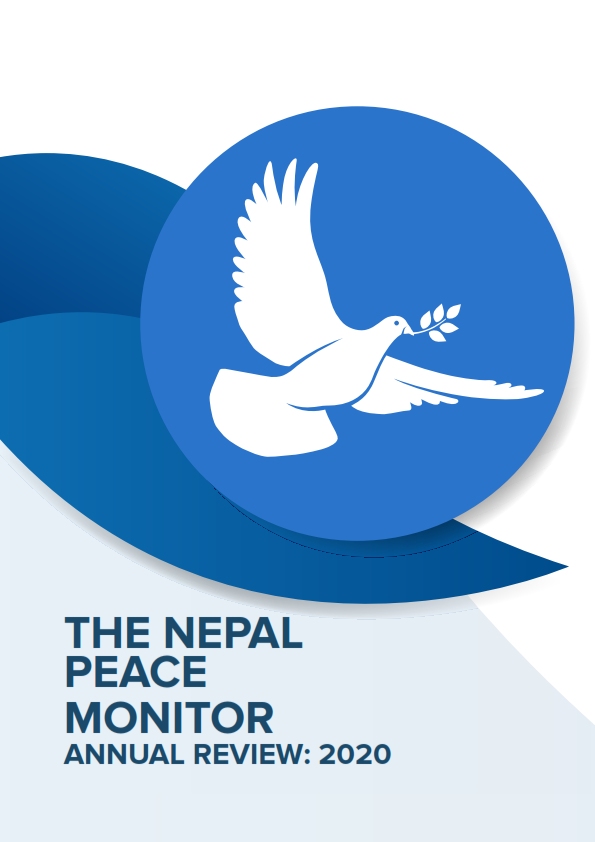
THE NEPAL PEACE MONITOR ANNUAL REVIEW: 2020
October 25, 2021
Human Trafficking / LGBT+ Rights / GBV / Political / Children’s Rights / Senior Citizens’ Rights / HRD Issues / Human Rights / Interpersonal Violence / Governance / Covid-19 / Civic-Space / PwD
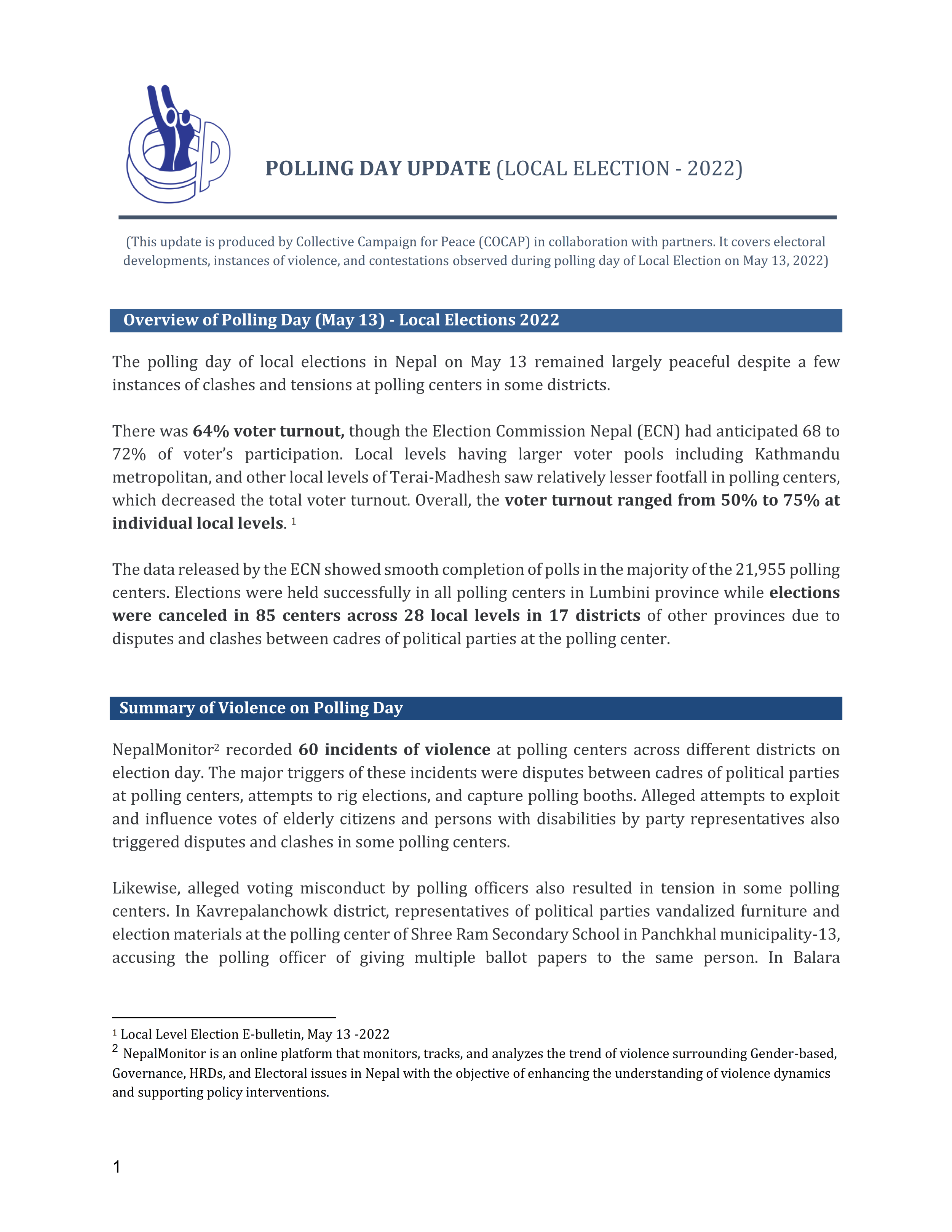
_001.png)
